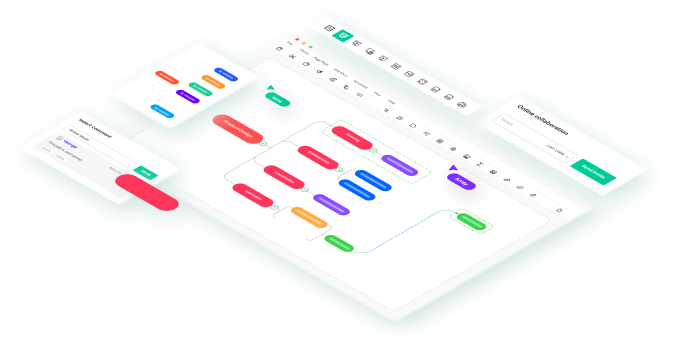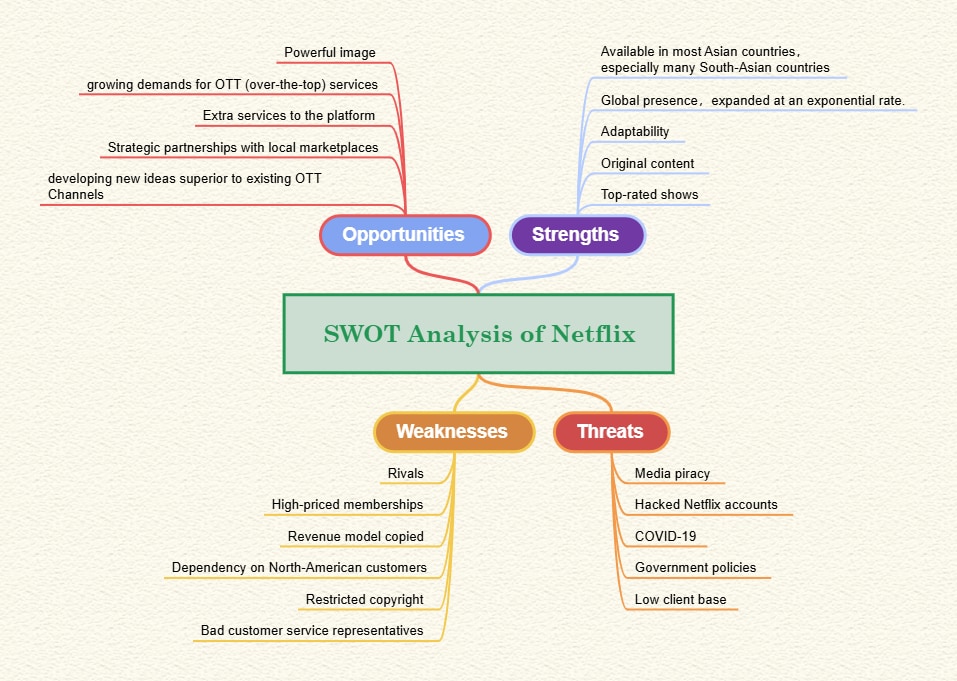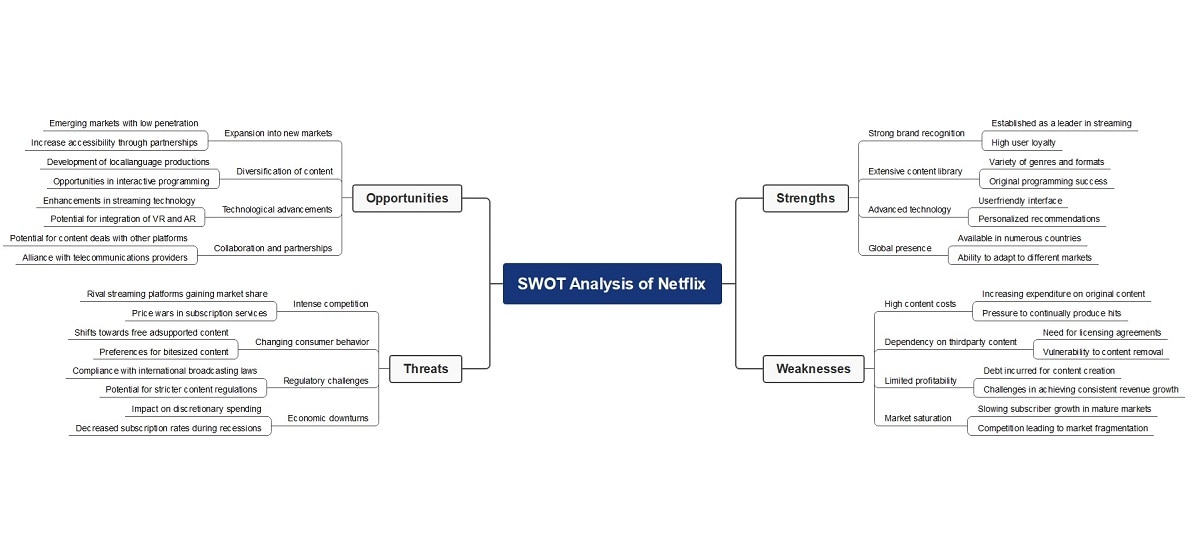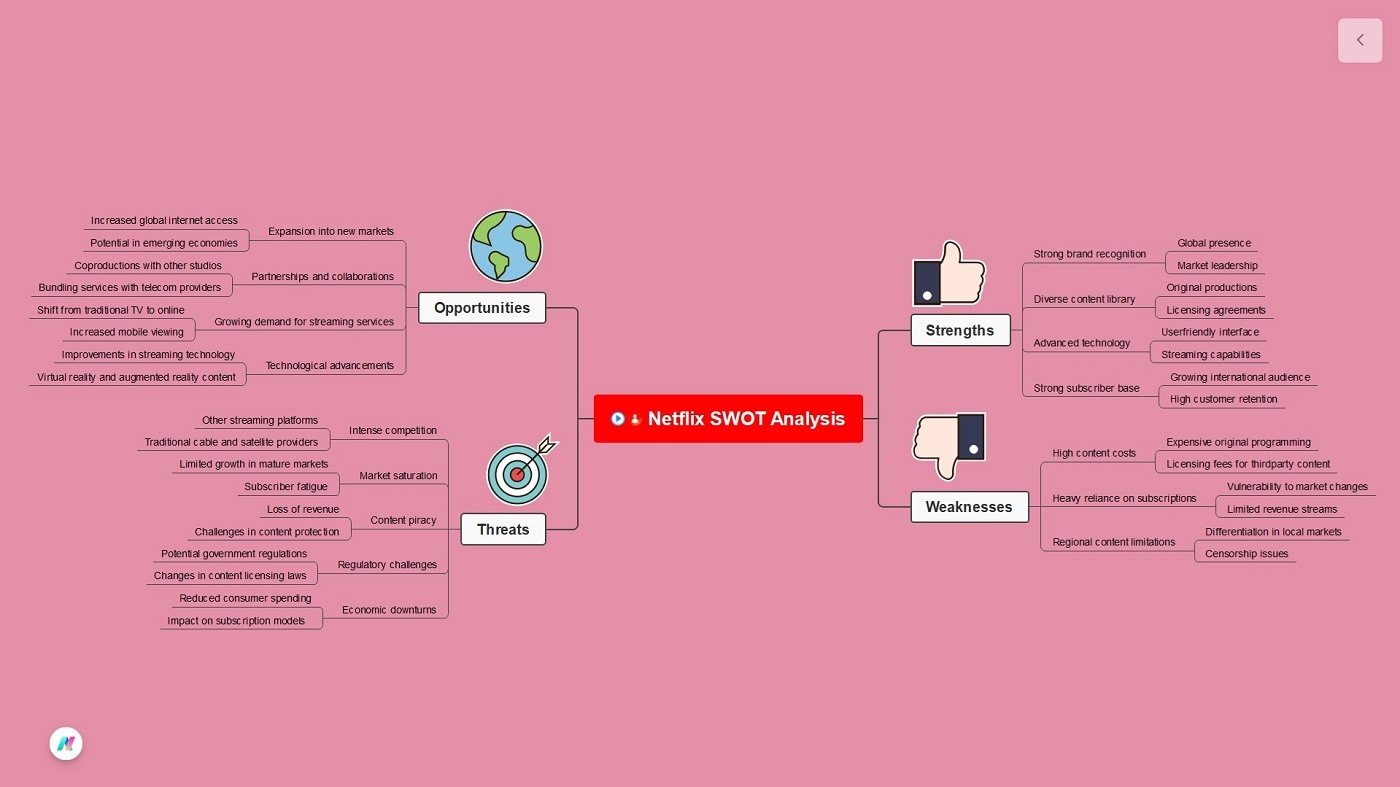Netflix has grown from a DVD rental service into one of the largest global streaming platforms. Its success is driven by innovation, original content, and global reach. Still, the company faces many challenges. Among them are rising competition, shifting audience preferences, and increasing production costs.
A SWOT analysis helps evaluate these factors. It breaks them into strengths, weaknesses, opportunities, and threats. It gives a clear view of where Netflix stands in today’s competitive market. For businesses and students studying media strategy, this framework provides useful insights into Netflix’s long-term positioning.
In This Article
What Is a SWOT Analysis?
A SWOT analysis is a tool used to evaluate a company’s internal and external environment. A SWOT analysis for a company like Netflix looks at four areas: strengths, weaknesses, opportunities, and threats.
- Strengths: Internal advantages like brand recognition, a large subscriber base, and original content.
- Weaknesses: Internal challenges such as high production costs, subscription dependency, or limited profitability in certain regions.
- Opportunities: Netflix can benefit from external trends like global expansion, localized content, and partnerships.
- Threats: External risks include competition from Disney+, Amazon Prime, HBO Max, and piracy.
For Netflix, SWOT analysis helps highlight why it has succeeded, what risks it must manage, and how it can grow.
Importance of SWOT Analysis in Streaming Platforms
The streaming industry is fast-paced, with new competitors and changing consumer habits. A SWOT analysis helps companies like Netflix assess their market standing. It guides leaders in planning strategies for retention, expansion, and innovation.
For instance, Netflix’s strong brand identity and global subscriber base are clear strengths. Weaknesses like heavy spending on original content show financial pressure—opportunities such as ad-supported plans or gaming expansion open new revenue streams. Meanwhile, threats include strong competitors like Disney+ or regulatory hurdles in international markets.
To see this in action, take a look at Netflix as a case study with a SWOT analysis diagram. The article will analyze its strengths, weaknesses, opportunities, and threats using EdrawMind.
Company Overview of Netflix

| Aspect | Information |
| Founded | 1997 (Los Gatos, California, USA) |
| Headquarters | Los Gatos, California, USA |
| Industry | Streaming media, entertainment, technology |
| Subscribers | ~300 million (2025, global) |
| Revenue | ~$35.5 Billion |
| Services | On-demand streaming, original content, ad-supported plans, and mobile gaming |
| Key Markets | Global (US, Europe, Asia-Pacific, Latin America) |
| Official Website | https://www.netflix.com |
Case Study: SWOT Analysis of Netflix
Netflix has transformed the entertainment industry through streaming, but faces strong competition and shifting markets. This SWOT analysis highlights its strengths, weaknesses, opportunities, and threats shaping future growth:
Strengths
Netflix has global brand recognition with a subscriber base of more than 300 million worldwide. It has an extensive library and exclusive original content. These include Stranger Things, The Crown, and Money Heist, setting it apart from competitors.
It also benefits from strong customer loyalty and advanced algorithms for personalized recommendations. Netflix’s global availability across devices strengthens its position as a leader in streaming.
Weaknesses
One weakness is Netflix’s dependence on continuous content spending. Original productions require billions annually, affecting profitability. Price increases risk pushing away cost-sensitive customers.
Another challenge is its heavy reliance on subscription revenue. Netflix lacks diversified income sources outside of streaming and gaming.
Opportunities
Global expansion in Africa and parts of Asia presents major growth opportunities. Localized content production has already proven successful in markets like South Korea and India.
Additionally, Netflix’s ad-supported subscription tier and entry into gaming offer new revenue streams. Strategic partnerships with telecom providers and smart TV manufacturers can drive subscriber growth.
Threats
The streaming market is highly competitive with Disney+, HBO Max, Amazon Prime Video, and Apple TV+. Piracy also threatens revenue in many markets.
Economic downturns may reduce consumer spending on non-essential subscriptions. Regulatory issues in certain countries could limit Netflix’s operations or raise compliance costs.
This case study shows how SWOT provides a clear picture of Netflix’s competitive position.
How To Make a SWOT Analysis for Netflix
A SWOT analysis is important for streaming platforms like Netflix. It shows what keeps the company successful and what challenges it faces. It identifies strengths like brand power and weaknesses like rising costs. It also indicates opportunities in global markets and threats from competition.
Netflix can plan strategies to expand into new markets. The company can innovate through ad-supported plans and reduce risks from competitors. It ensures the company adapts to industry changes and continues leading the streaming space.
Steps To Make a SWOT Analysis Mind Map
Creating a SWOT analysis mind map helps you organize insights with ease. With a good diagram maker, you can map Netflix’s strengths, weaknesses, opportunities, and threats step by step. It makes the analysis clear, engaging, and easy to present.
Follow these steps to create a detailed Netflix SWOT analysis mind map using Wondershare EdrawMind:
Step1 Download and install EdrawMind on your computer
Next, log in or register for a Wondershare account. Start a new project by selecting Local MindMap.
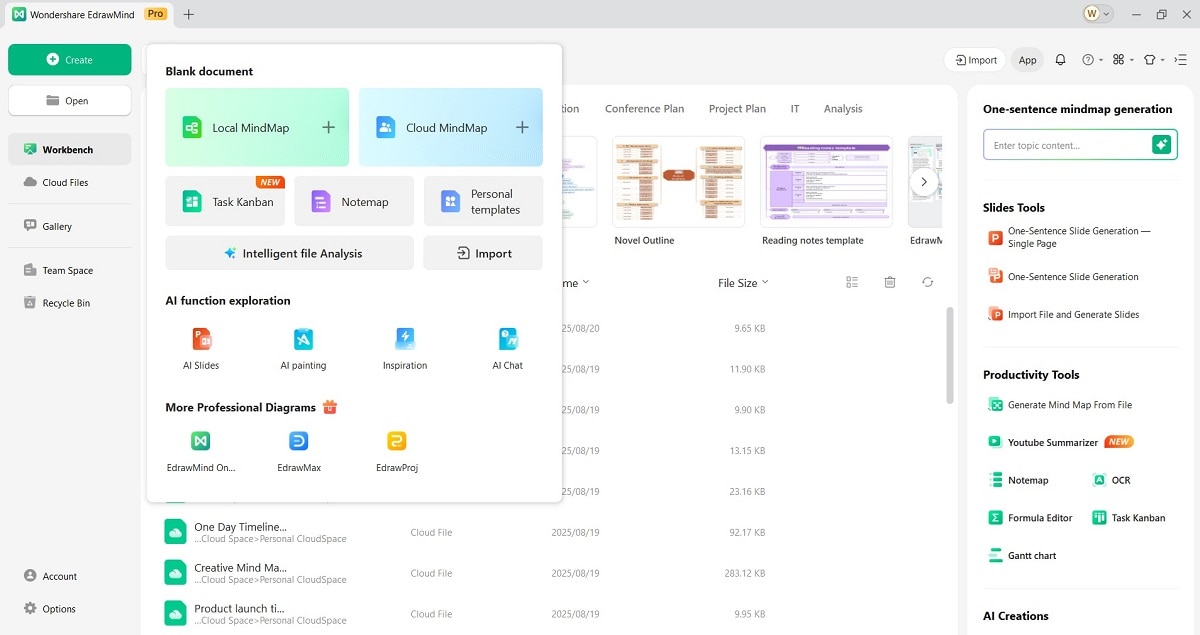
Step2 Decide what you want your Netflix SWOT analysis to achieve
For example, you may want to evaluate Netflix’s current market strength. Analyze new content strategies or assess international expansion potential.
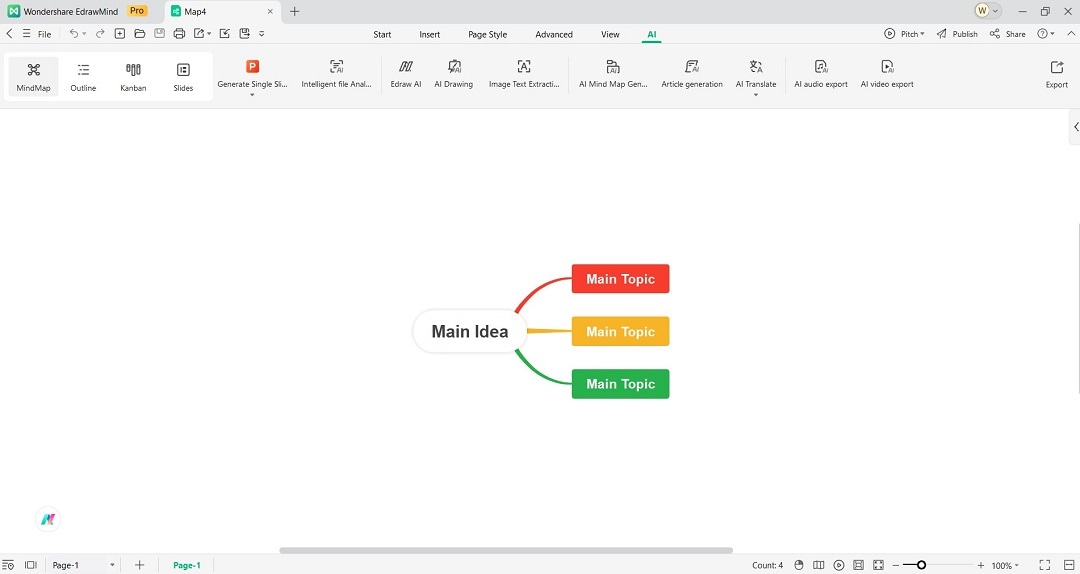
Step3 Add the Central Topic “Netflix SWOT Analysis”
Place this in the center of the map. Create four main branches labeled Strengths, Weaknesses, Opportunities, and Threats. These act as the framework for organizing your insights.
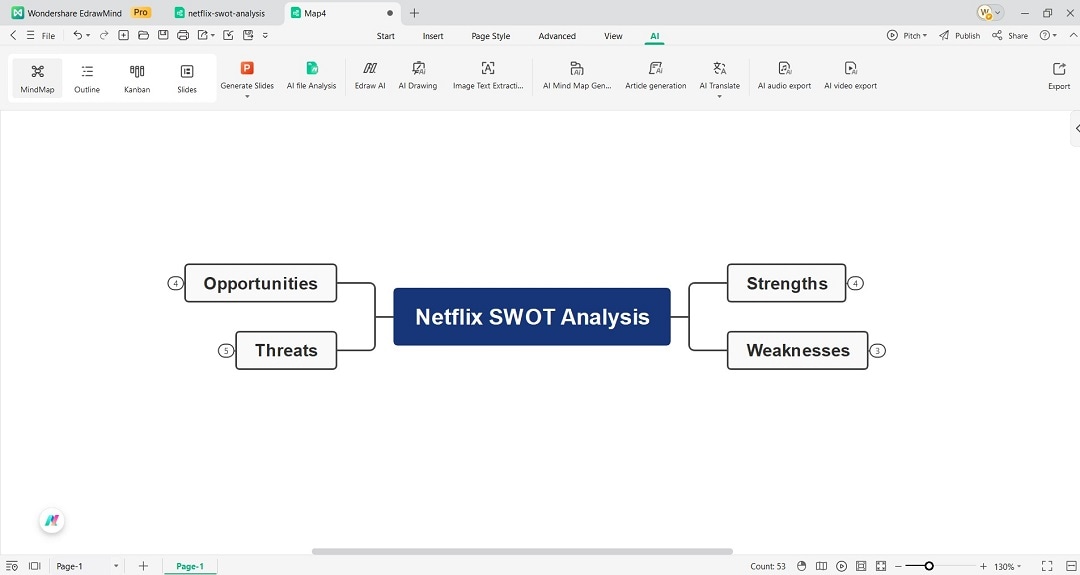
Step4 Fill in strengths like Netflix’s global brand recognition and original content
Weaknesses are high production costs, and opportunities like growth in emerging markets. Threats are increasing competition from Disney+ or Amazon Prime.
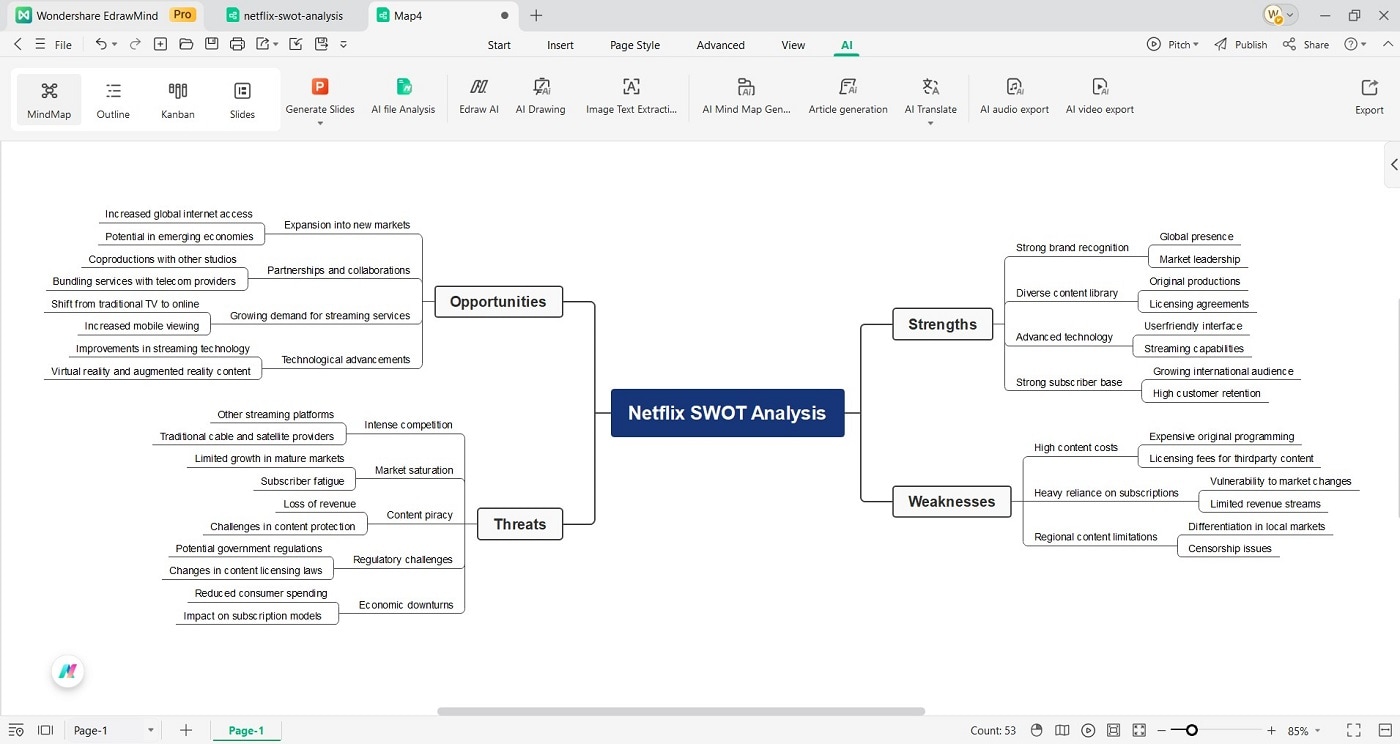
Step5 Customize the mind map
Use colors, icons, and themes to highlight important factors. Use the right-side panel to customize your mind map according to your preference.
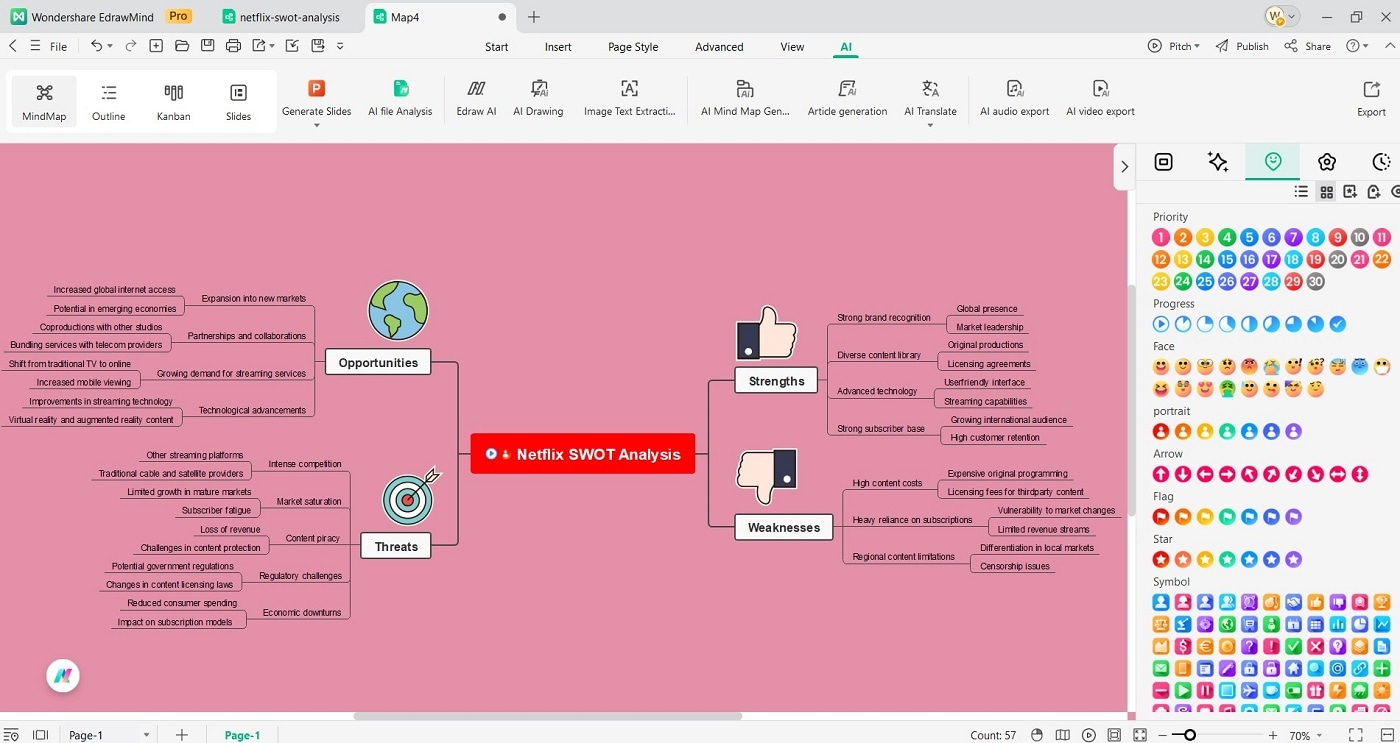
Step6 Once complete, export the SWOT mind map to formats like PDF, PowerPoint, or image files
This makes it easy to present findings in meetings, reports, or academic projects.
Tips for Better SWOT Mind Maps
When creating a SWOT mind map, focus on clarity and organization. Use short, direct phrases instead of long sentences so the map stays easy to read.
It’s recommended to color-code each quadrant or add identifying icons. This makes the diagram easier to understand at a glance. If working in teams, assign specific sections to members, then review together to ensure all perspectives are included. This approach balances speed with accuracy.
Key Takeaways
A SWOT analysis helps transform scattered information into an organized, visual structure. It shows your strengths, weaknesses, opportunities, and threats in a connected format. It allows businesses to see relationships and patterns that may not be obvious in plain text.
This approach makes strategy planning more effective. SWOT analysis improves collaboration among teams. It also ensures decisions are based on clear and well-structured insights. Revisit and refine the map to stay aligned with company goals and market changes.
FAQS
-
How can EdrawMind improve a Netflix SWOT diagram?
EdrawMind simplifies the process of making SWOT diagrams with ready-made SWOT templates. You can make AI-generated branches and use collaborative tools.
When applied to Netflix, these features help teams map out ideas faster. It ensures accuracy and creates visuals that are easy to present in reports or meetings. -
How does a SWOT diagram help visualize Netflix’s business situation?
A SWOT diagram turns complex information about Netflix into an easy-to-read visual map. Instead of long reports, the diagram highlights the company’s strengths or weaknesses. You can also reveal external opportunities and threats.
This clear layout helps analysts identify strategic priorities. You can improve original content, manage subscription costs, or respond to streaming rivals. -
Can Netflix’s SWOT analysis change over time?
Yes, Netflix’s SWOT analysis is not fixed. Changes in audience behavior or technological shifts can reshape its opportunities and threats.
For example, the rise of short-form video platforms added new challenges. Meanwhile, global expansion creates more opportunities. Updating the SWOT diagram ensures that the analysis stays relevant.



